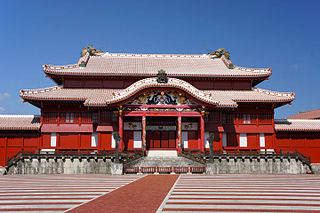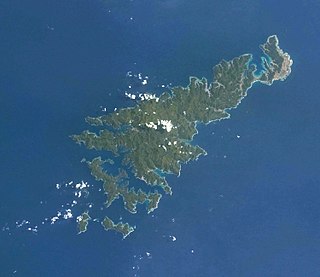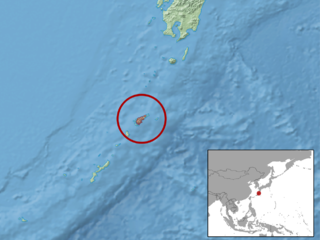
Okinawa Prefecture is the southernmost and westernmost prefecture of Japan. It has a population of 1,457,162 and a geographic area of 2,281 km2.

The Ryukyuan people are a Japonic-speaking East Asian ethnic group native to the Ryukyu Islands, which stretch between the islands of Kyushu and Taiwan. Administratively, they live in either Okinawa Prefecture or Kagoshima Prefecture within Japan. They speak one of the Ryukyuan languages, considered to be one of the two branches of the Japonic language family, the other being Japanese and its dialects.

This article is about the history of the Ryukyu Islands southwest of the main islands of Japan.

The Ryukyu Kingdom was a kingdom in the Ryukyu Islands from 1429 to 1879. It was ruled as a tributary state of imperial Ming China by the Ryukyuan monarchy, who unified Okinawa Island to end the Sanzan period, and extended the kingdom to the Amami Islands and Sakishima Islands. The Ryukyu Kingdom played a central role in the maritime trade networks of medieval East Asia and Southeast Asia despite its small size. The Ryukyu Kingdom became a vassal state of the Satsuma Domain of Japan after the invasion of Ryukyu in 1609 but retained de jure independence until it was transformed into the Ryukyu Domain by the Empire of Japan in 1872. The Ryukyu Kingdom was formally annexed and dissolved by Japan in 1879 to form Okinawa Prefecture, and the Ryukyuan monarchy was integrated into the new Japanese nobility.

Okinawa Island, officially Okinawa Main Island, is the largest of the Okinawa Islands and the Ryukyu (Nansei) Islands of Japan in the Kyushu region. It is the smallest and least populated of the five main islands of Japan. The island is approximately 106 kilometres (66 mi) long, an average 11 kilometres (7 mi) wide, and has an area of 1,206.98 square kilometers (466.02 sq mi). It is roughly 640 kilometres south of the main island of Kyushu and the rest of Japan. It is 500 km northeast of Taiwan. The total population of Okinawa Island is 1,384,762. The greater Naha area has roughly 800,000 residents, while the city itself has about 320,000 people. Naha is the seat of Okinawa Prefecture on the southwestern part of Okinawa Island. Okinawa has a humid subtropical climate.

Amami Ōshima, also known as Amami, is the largest island in the Amami archipelago between Kyūshū and Okinawa. It is one of the Satsunan Islands.

The Old World rats and mice, part of the subfamily Murinae in the family Muridae, comprise at least 519 species. Members of this subfamily are called murines. In terms of species richness, this subfamily is larger than all mammal families except the Cricetidae and Muridae, and is larger than all mammal orders except the bats and the remainder of the rodents.

Broussonetia is a genus of four species of trees in the family Moraceae, native to eastern Asia. These four species have high-quality fiber which consist of more than 90% of cellulose. They are traditionally applied for various daily necessities in South Eastern Asia and papermaking in East Asia.

Apodemus is a genus of Muridae. The name is unrelated to that of the Mus genus, instead being derived from the Greek ἀπό-δημος.

Naha is the capital city of Okinawa Prefecture, the southernmost prefecture of Japan. As of 1 June 2019, the city has an estimated population of 317,405 and a population density of 7,939 people per km2. The total area is 39.98 km2 (15.44 sq mi).

The Ryukyu independence movement or the Republic of the Ryukyus is a political movement advocating for the independence of the Ryukyu Islands from Japan.

The Ryukyu Islands, also known as the Nansei Islands or the Ryukyu Arc, are a chain of Japanese islands that stretch southwest from Kyushu to Taiwan: the Ōsumi, Tokara, Amami, Okinawa, and Sakishima Islands, with Yonaguni the westernmost. The larger are mostly volcanic islands and the smaller mostly coral. The largest is Okinawa Island.

The Ryukyu long-tailed giant rat or Ryukyu rat is a species of rodent in the family Muridae. It is the only extant species in the genus Diplothrix. It is found only in the Ryukyu Islands of Japan. Its natural habitat is temperate forests.

The Ryukyu mouse is a species of rodent in the family Muridae. It is found in Cambodia, China, Indonesia, Japan, Laos, Malaysia, Taiwan, Thailand, and Vietnam.

The Ryukyu spiny rat is a species of rodent in the family Muridae. Endemic to Amami Ōshima island in the Amami Islands of the Ryukyu archipelago of Japan, its natural habitat is subtropical moist broadleaf forest. The karyotype has an odd diploid number, 2n = 25. Like its relative T. tokunoshimensis, it has lost its Y chromosome and SRY gene.

The Senkaku Islands dispute, or Diaoyu Islands dispute, is a territorial dispute over a group of uninhabited islands known as the Senkaku Islands in Japan, the Diaoyu Islands in China, and Tiaoyutai Islands in Taiwan. Aside from a 1945 to 1972 period of administration by the United States as part of the Ryukyu Islands, the archipelago has been controlled by Japan since 1895. The territory is close to key shipping lanes and rich fishing grounds, and there may be oil reserves in the area.
Shiraho Saonetabaru Cave Ruins is a paleoanthropological site located on Ishigaki Island of the Yaeyama Islands in Japan. Shiraho Saonetabaru is a limestone cave.

The Ryukyu Disposition, also called the Ryukyu Annexation or the annexation of Okinawa, was the political process during the early years of the Meiji period that saw the incorporation of the former Ryukyu Kingdom into the Empire of Japan as Okinawa Prefecture and its decoupling from the Chinese tributary system. These processes began with the creation of Ryukyu Domain in 1872 and culminated in the kingdom's annexation and final dissolution in 1879; immediate diplomatic fallout and consequent negotiations with Qing China, brokered by Ulysses S. Grant, effectively came to an end late the following year. The term is also sometimes used more narrowly in relation to the events and changes of 1879 alone. The Ryūkyū Disposition has been "alternatively characterized as aggression, annexation, national unification, or internal reform".

Apodemini is a tribe of muroid rodents in the subfamily Murinae. It contains two extant genera, one found throughout Eurasia and the other endemic to the Ryukyu Islands. Several fossil genera are also known from throughout Eurasia, including one large species (Rhagamys) that persisted on Sardinia and Corsica up until at least the first millennium BC, when it was likely wiped out by human activity.

The Ryukyu Arc is an island arc which extends from the south of Kyushu along the Ryukyu Islands to the northeast of Taiwan, spanning about 1,200 kilometres (750 mi). It is located along a section of the convergent plate boundary where the Philippine Sea Plate is subducting northwestward beneath the Eurasian Plate along the Ryukyu Trench. The arc has an overall northeast to southwest trend and is located northwest of the Pacific Ocean and southeast of the East China Sea. It runs parallel to the Okinawa Trough, an active volcanic arc, and the Ryukyu Trench. The Ryukyu Arc, based on its geomorphology, can be segmented from north to south into Northern Ryukyu, Central Ryukyu, and Southern Ryukyu; the Tokara Strait separates Northern Ryukyu and Central Ryukyu at about 130˚E while the Kerama Gap separates Central Ryukyu and Southern Ryukyu at about 127 ˚E. The geological units of the arc include igneous, sedimentary, and metamorphic rocks, ranging from the Paleozoic to Cenozoic in age.



















